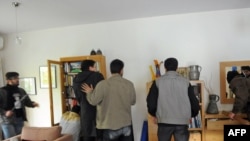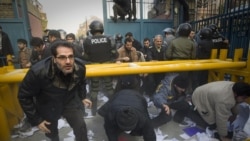A member of the Iranian parliament has disclosed that "270 billion rials of people's money" was paid to the United Kingdom as compensation for damages incurred in an attack by hardliners on London’s embassy in 2011 in Tehran.
According to the pro-reformist MP Ahmad Mazani, the compensation which amounted to 1.3 million pounds was paid for the restoration of several pieces of art that had been destroyed during the attack on the embassy.
The issue of compensation to the British government has been raised since 2014, following an agreement between Tehran and London to reopen their embassies, but no details have been released. It is not clear when the payment was made.
The state-run Iran Labor News Agency (ILNA) cited mid-ranking cleric, Mazani, as saying in a public session of parliament on May 10, that the Islamic Republic Foreign Ministry should investigate and clarify the case.
The 2011 attack on the British Embassy in Tehran was triggered by London's decision to impose numerous sanctions on Iran regarding concerns over the nature of the Islamic Republic's nuclear program.
On November 29, 2011, about 1,000 protesters gathered near the embassy in Tehran calling the Islamic Republic authorities to expel the British ambassador immediately. Although the rally began quietly, some participants, calling themselves "students", stormed the building, breaking down the gate, tearing portraits of Queen Elizabeth II, throwing around papers and replacing the British flag with the Islamic Republic's. Nevertheless, Iranian security forces initially stayed away as the so-called students entered the building, chanting "Death to America", "Death to England" and "Death to Israel", among other slogans.
The main building of the British embassy in central Tehran, completed in 1876, was designed by the famous British architect James Wild and is a unique fusion of western and Iranian architecture. The British embassy in Tehran is also known for being the venue of the Tehran Conference, a meeting of Joseph Stalin, Franklin D. Roosevelt and Winston Churchill in 1943.
Several of the historical paintings adorning the walls of the embassy, including a unique portrait of Fath-Ali Shah Qajar (1772 – 1834), were badly damaged by the attackers who tore them with knives. The portrait has been restored in Britain and sent back to Iran.
British Ambassador to Iran Dominick Chilcott maintained in 2011 that protesters rampaged through the embassy building, destroying paintings and furniture, spraying graffiti, smashing windows and starting fires. Seven embassy staff were seized by protesters but were eventually escorted out by the security forces. The protesters also stole British diplomats' mobile phones and computers. None of the assailants were arrested.






